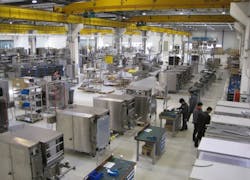Last year, U.S. packaging machinery shipments increased 6% to $7.9 billion. In addition, a rise in retail-ready packaging (RRP) is changing the role of secondary packaging.
Both of these findings come courtesy of the Association for Packaging and Processing Technologies (PMMI) via two newly released studies: “2014 State of the Industry: Packaging Machinery Shipments Study (SOTI)” and “2014 Secondary Packaging Market Research Study.” The results were shared at a Nov. 4 press briefing held at PACK EXPO International and Pharma EXPO 2014 in Chicago. PMI is the owner and producer of PACK EXPO.
PMMI member packaging machinery manufacturers provided data for their 2012 and 2013 shipments for this study. Total U.S. packaging machinery shipment estimates also incorporated projected non-member shipments.
“Total U.S. consumption—an overall figure that includes imports, exports, and domestic shipment—reached $9 billion in 2013,” says Jorge Izquierdo, vice president, Market Development, PMMI. “Foods and beverages together continue to account for more than half of the shipments. This is consistent with what we’ve seen over the past 10 years.”
While the “SOTI” study illustrated a consistent overall market, PMMI’s “2014 Secondary Packaging Market Research Study” revealed a dynamic industry segment feeling the strength of consumer trends.
“In 2008, when we last conducted this survey, every company we spoke to said they were trying to reduce their costs and improve their sustainability ratings in secondary packaging, and retailers demanded those changes because of consumer preferences,” Izquierdo says. “In contrast, roughly half of the 2014 study participants say they’ve implemented those changes and are satisfied with the results.”
One of the most visible trends for secondary packaging, however, is its role as a retail-ready packaging medium. Izquierdo adds, “Retailers are asking for more shelf display containers and, as a result, we’re seeing secondary packaging going directly from pallet to store shelf.”
Changes in primary packaging are also driving shifts in secondary packaging, the report notes. Food and beverage producers (45 and 50%, respectively) noted changes such as switching flexible packaging and lightweighting primary packaging are resulting in the need for stronger support from secondary packaging.
The 2014 study also shows a decrease in RSC usage and corrugated fiberboard materials, as well as an increase in the use of recycled material content, overwrapped trays, and shrink-wrapped pads.
Executive summaries of both reports are available at PMMI’s PACK EXPO booth (N–4550), as well as on the organization’s website.
